Impact of Mount Merapi Eruption on Tourism Industry in Indonesia
VerifiedAdded on 2023/06/16
|11
|3806
|340
AI Summary
This journal article discusses the impact of Mount Merapi eruption on the tourism industry in Indonesia. It covers the pre-disaster context, during the disaster, and future disaster context. The article also provides insights on disaster management and recovery phase.
Contribute Materials
Your contribution can guide someone’s learning journey. Share your
documents today.

INDIVIDUAL
JOURNAL ARTICLE
JOURNAL ARTICLE
Secure Best Marks with AI Grader
Need help grading? Try our AI Grader for instant feedback on your assignments.
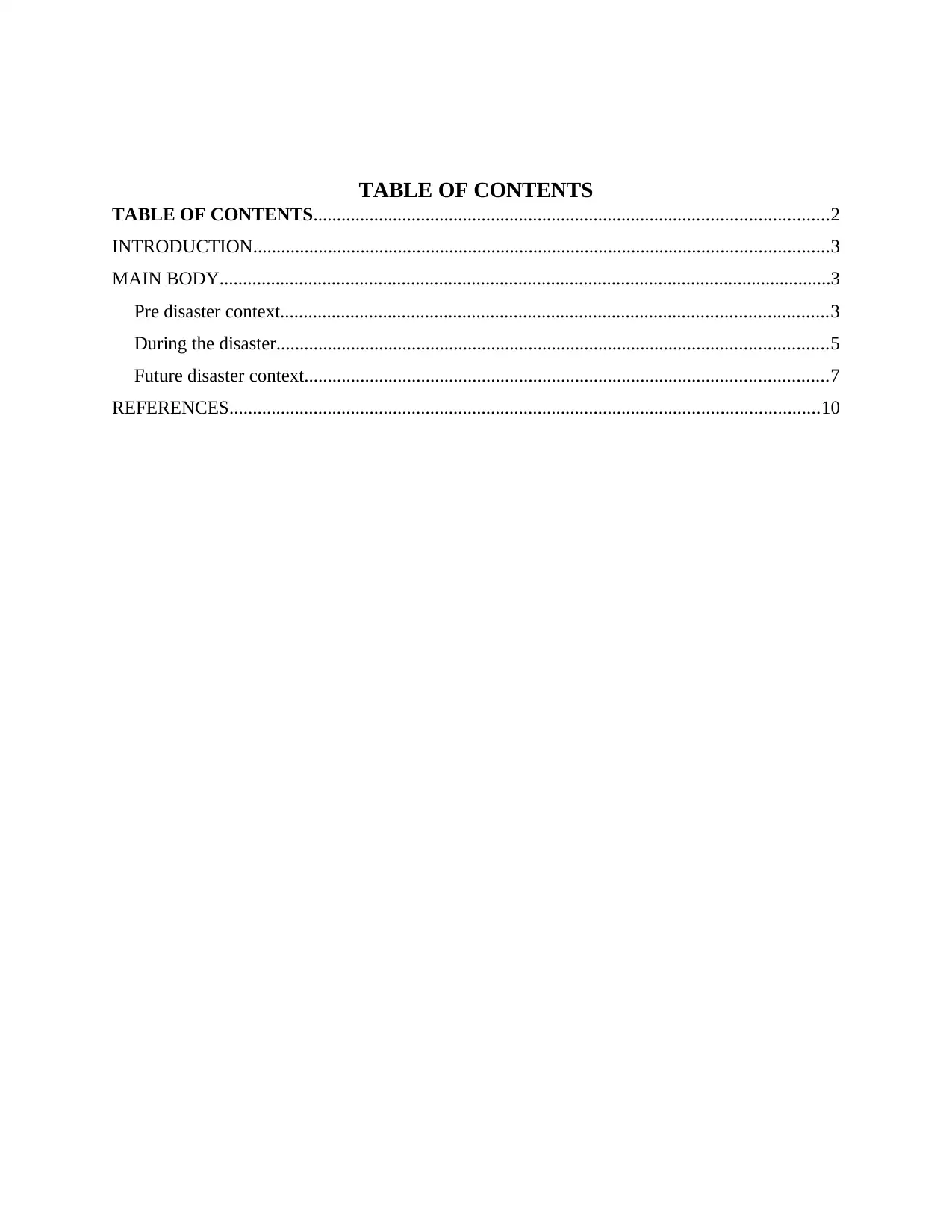
TABLE OF CONTENTS
TABLE OF CONTENTS..............................................................................................................2
INTRODUCTION...........................................................................................................................3
MAIN BODY...................................................................................................................................3
Pre disaster context.....................................................................................................................3
During the disaster......................................................................................................................5
Future disaster context................................................................................................................7
REFERENCES..............................................................................................................................10
TABLE OF CONTENTS..............................................................................................................2
INTRODUCTION...........................................................................................................................3
MAIN BODY...................................................................................................................................3
Pre disaster context.....................................................................................................................3
During the disaster......................................................................................................................5
Future disaster context................................................................................................................7
REFERENCES..............................................................................................................................10
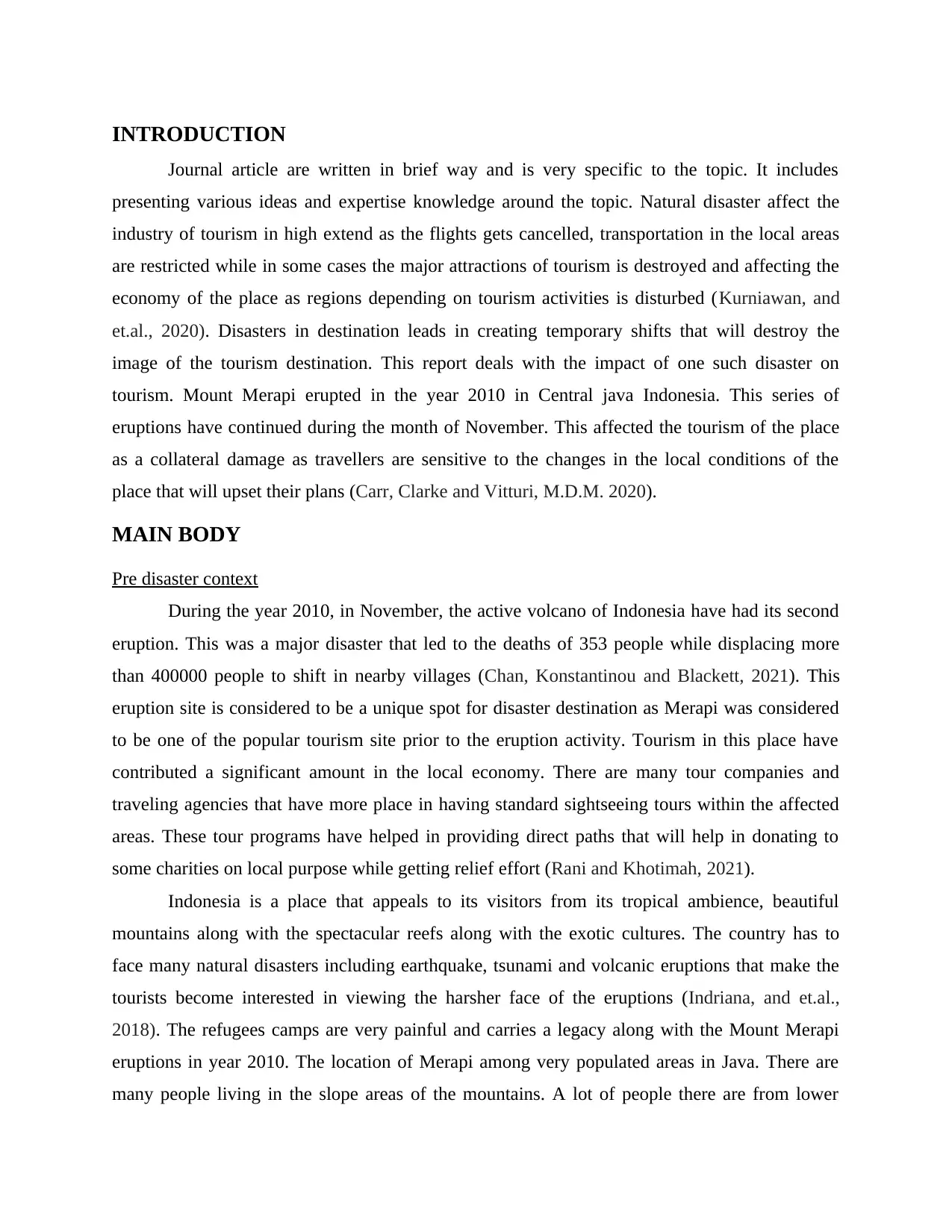
INTRODUCTION
Journal article are written in brief way and is very specific to the topic. It includes
presenting various ideas and expertise knowledge around the topic. Natural disaster affect the
industry of tourism in high extend as the flights gets cancelled, transportation in the local areas
are restricted while in some cases the major attractions of tourism is destroyed and affecting the
economy of the place as regions depending on tourism activities is disturbed (Kurniawan, and
et.al., 2020). Disasters in destination leads in creating temporary shifts that will destroy the
image of the tourism destination. This report deals with the impact of one such disaster on
tourism. Mount Merapi erupted in the year 2010 in Central java Indonesia. This series of
eruptions have continued during the month of November. This affected the tourism of the place
as a collateral damage as travellers are sensitive to the changes in the local conditions of the
place that will upset their plans (Carr, Clarke and Vitturi, M.D.M. 2020).
MAIN BODY
Pre disaster context
During the year 2010, in November, the active volcano of Indonesia have had its second
eruption. This was a major disaster that led to the deaths of 353 people while displacing more
than 400000 people to shift in nearby villages (Chan, Konstantinou and Blackett, 2021). This
eruption site is considered to be a unique spot for disaster destination as Merapi was considered
to be one of the popular tourism site prior to the eruption activity. Tourism in this place have
contributed a significant amount in the local economy. There are many tour companies and
traveling agencies that have more place in having standard sightseeing tours within the affected
areas. These tour programs have helped in providing direct paths that will help in donating to
some charities on local purpose while getting relief effort (Rani and Khotimah, 2021).
Indonesia is a place that appeals to its visitors from its tropical ambience, beautiful
mountains along with the spectacular reefs along with the exotic cultures. The country has to
face many natural disasters including earthquake, tsunami and volcanic eruptions that make the
tourists become interested in viewing the harsher face of the eruptions (Indriana, and et.al.,
2018). The refugees camps are very painful and carries a legacy along with the Mount Merapi
eruptions in year 2010. The location of Merapi among very populated areas in Java. There are
many people living in the slope areas of the mountains. A lot of people there are from lower
Journal article are written in brief way and is very specific to the topic. It includes
presenting various ideas and expertise knowledge around the topic. Natural disaster affect the
industry of tourism in high extend as the flights gets cancelled, transportation in the local areas
are restricted while in some cases the major attractions of tourism is destroyed and affecting the
economy of the place as regions depending on tourism activities is disturbed (Kurniawan, and
et.al., 2020). Disasters in destination leads in creating temporary shifts that will destroy the
image of the tourism destination. This report deals with the impact of one such disaster on
tourism. Mount Merapi erupted in the year 2010 in Central java Indonesia. This series of
eruptions have continued during the month of November. This affected the tourism of the place
as a collateral damage as travellers are sensitive to the changes in the local conditions of the
place that will upset their plans (Carr, Clarke and Vitturi, M.D.M. 2020).
MAIN BODY
Pre disaster context
During the year 2010, in November, the active volcano of Indonesia have had its second
eruption. This was a major disaster that led to the deaths of 353 people while displacing more
than 400000 people to shift in nearby villages (Chan, Konstantinou and Blackett, 2021). This
eruption site is considered to be a unique spot for disaster destination as Merapi was considered
to be one of the popular tourism site prior to the eruption activity. Tourism in this place have
contributed a significant amount in the local economy. There are many tour companies and
traveling agencies that have more place in having standard sightseeing tours within the affected
areas. These tour programs have helped in providing direct paths that will help in donating to
some charities on local purpose while getting relief effort (Rani and Khotimah, 2021).
Indonesia is a place that appeals to its visitors from its tropical ambience, beautiful
mountains along with the spectacular reefs along with the exotic cultures. The country has to
face many natural disasters including earthquake, tsunami and volcanic eruptions that make the
tourists become interested in viewing the harsher face of the eruptions (Indriana, and et.al.,
2018). The refugees camps are very painful and carries a legacy along with the Mount Merapi
eruptions in year 2010. The location of Merapi among very populated areas in Java. There are
many people living in the slope areas of the mountains. A lot of people there are from lower
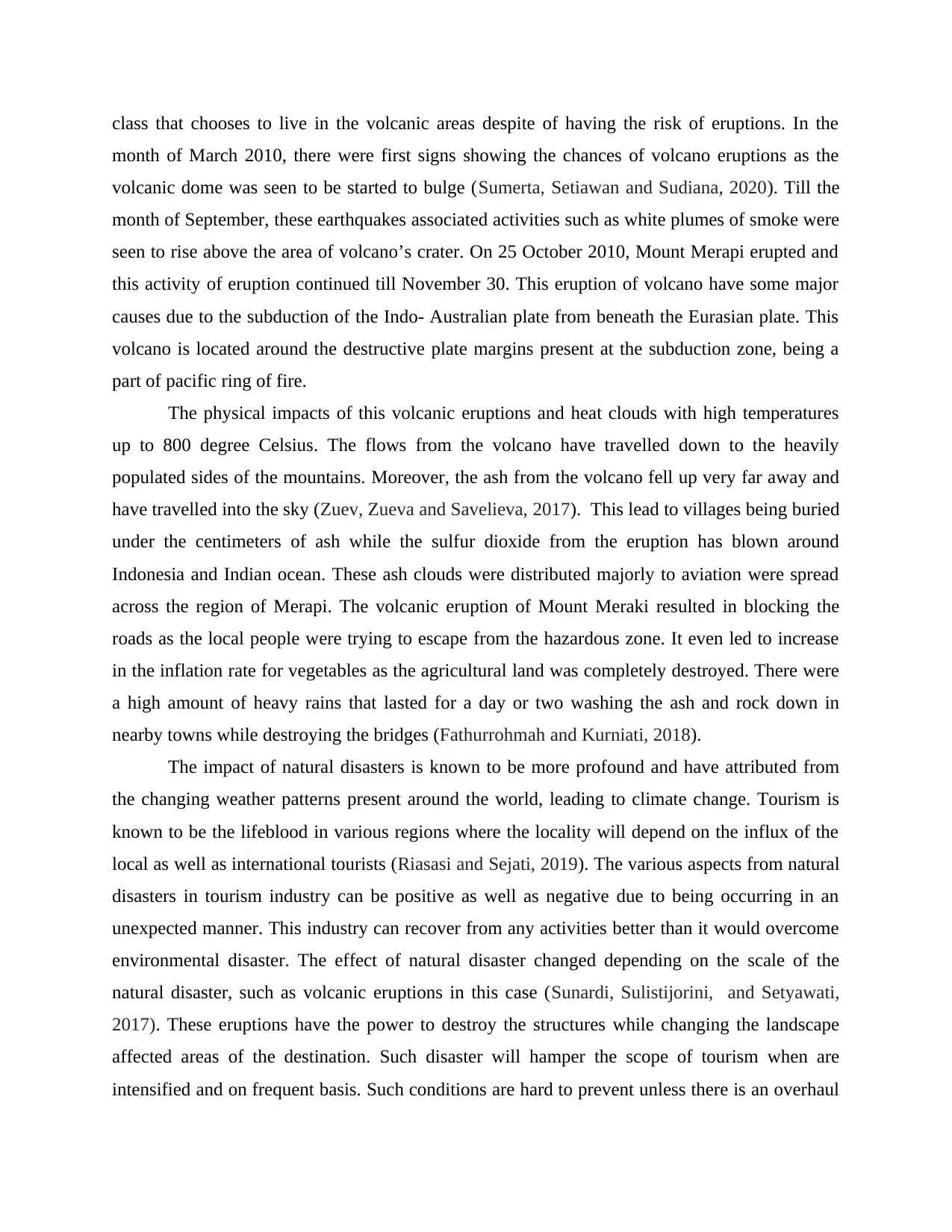
class that chooses to live in the volcanic areas despite of having the risk of eruptions. In the
month of March 2010, there were first signs showing the chances of volcano eruptions as the
volcanic dome was seen to be started to bulge (Sumerta, Setiawan and Sudiana, 2020). Till the
month of September, these earthquakes associated activities such as white plumes of smoke were
seen to rise above the area of volcano’s crater. On 25 October 2010, Mount Merapi erupted and
this activity of eruption continued till November 30. This eruption of volcano have some major
causes due to the subduction of the Indo- Australian plate from beneath the Eurasian plate. This
volcano is located around the destructive plate margins present at the subduction zone, being a
part of pacific ring of fire.
The physical impacts of this volcanic eruptions and heat clouds with high temperatures
up to 800 degree Celsius. The flows from the volcano have travelled down to the heavily
populated sides of the mountains. Moreover, the ash from the volcano fell up very far away and
have travelled into the sky (Zuev, Zueva and Savelieva, 2017). This lead to villages being buried
under the centimeters of ash while the sulfur dioxide from the eruption has blown around
Indonesia and Indian ocean. These ash clouds were distributed majorly to aviation were spread
across the region of Merapi. The volcanic eruption of Mount Meraki resulted in blocking the
roads as the local people were trying to escape from the hazardous zone. It even led to increase
in the inflation rate for vegetables as the agricultural land was completely destroyed. There were
a high amount of heavy rains that lasted for a day or two washing the ash and rock down in
nearby towns while destroying the bridges (Fathurrohmah and Kurniati, 2018).
The impact of natural disasters is known to be more profound and have attributed from
the changing weather patterns present around the world, leading to climate change. Tourism is
known to be the lifeblood in various regions where the locality will depend on the influx of the
local as well as international tourists (Riasasi and Sejati, 2019). The various aspects from natural
disasters in tourism industry can be positive as well as negative due to being occurring in an
unexpected manner. This industry can recover from any activities better than it would overcome
environmental disaster. The effect of natural disaster changed depending on the scale of the
natural disaster, such as volcanic eruptions in this case (Sunardi, Sulistijorini, and Setyawati,
2017). These eruptions have the power to destroy the structures while changing the landscape
affected areas of the destination. Such disaster will hamper the scope of tourism when are
intensified and on frequent basis. Such conditions are hard to prevent unless there is an overhaul
month of March 2010, there were first signs showing the chances of volcano eruptions as the
volcanic dome was seen to be started to bulge (Sumerta, Setiawan and Sudiana, 2020). Till the
month of September, these earthquakes associated activities such as white plumes of smoke were
seen to rise above the area of volcano’s crater. On 25 October 2010, Mount Merapi erupted and
this activity of eruption continued till November 30. This eruption of volcano have some major
causes due to the subduction of the Indo- Australian plate from beneath the Eurasian plate. This
volcano is located around the destructive plate margins present at the subduction zone, being a
part of pacific ring of fire.
The physical impacts of this volcanic eruptions and heat clouds with high temperatures
up to 800 degree Celsius. The flows from the volcano have travelled down to the heavily
populated sides of the mountains. Moreover, the ash from the volcano fell up very far away and
have travelled into the sky (Zuev, Zueva and Savelieva, 2017). This lead to villages being buried
under the centimeters of ash while the sulfur dioxide from the eruption has blown around
Indonesia and Indian ocean. These ash clouds were distributed majorly to aviation were spread
across the region of Merapi. The volcanic eruption of Mount Meraki resulted in blocking the
roads as the local people were trying to escape from the hazardous zone. It even led to increase
in the inflation rate for vegetables as the agricultural land was completely destroyed. There were
a high amount of heavy rains that lasted for a day or two washing the ash and rock down in
nearby towns while destroying the bridges (Fathurrohmah and Kurniati, 2018).
The impact of natural disasters is known to be more profound and have attributed from
the changing weather patterns present around the world, leading to climate change. Tourism is
known to be the lifeblood in various regions where the locality will depend on the influx of the
local as well as international tourists (Riasasi and Sejati, 2019). The various aspects from natural
disasters in tourism industry can be positive as well as negative due to being occurring in an
unexpected manner. This industry can recover from any activities better than it would overcome
environmental disaster. The effect of natural disaster changed depending on the scale of the
natural disaster, such as volcanic eruptions in this case (Sunardi, Sulistijorini, and Setyawati,
2017). These eruptions have the power to destroy the structures while changing the landscape
affected areas of the destination. Such disaster will hamper the scope of tourism when are
intensified and on frequent basis. Such conditions are hard to prevent unless there is an overhaul
Secure Best Marks with AI Grader
Need help grading? Try our AI Grader for instant feedback on your assignments.

present on the environmental issues. Therefore it makes it important for the industry to take
account of various possibilities of natural disasters while ensuring the sustainability of the
business (Ramdhan, Laurin and Fahmi, 2019).
During the disaster
This volcano disaster which is called Mount Merapi happened in Central Java, October
2010, Indonesia. It began with the violent series of the eruption that would be continued in
November. These seismic activities are started in September and culminating for repeated
outbursts of an ashes and lava. The large eruption is formed in column that caused numerously in
pyroclastic flows with down the heavy slop of the volcano. It is the largest eruption that can be
said by authorities. There are more than 360,000 people are affected for that particular area and
400 people were killed during the volcano eruption. The main cause for the volcano and its
eruption are caused due to Indo Australian Plate which is being subducted the beneath in order to
distract the Eurasian Plate (Kusumayudha and Paripurno, 2018). The location of the volcano is
on the destructive margin of plates at subduction zone and the part fire ring of pacific.
The main cause of the eruption is happened when the magma the rock are rises for the surface
and it is formed while the earth mantle starting melts. Another cause is related to water
underneath and the surface interacting with the hot magma that create steam, also it can be
putting more pressure for causing an explosion. The most common type of eruption can be
caused due to tectonic plates movements (Mei, Anggriani and Niam, 2019). If the one plate
pushed under magma the seawater and sediment forced into the chamber that eventually flows
for volcano eruption and spewing in the sky. In context to tourism industry Indonesia appeal to
the visitors to come tropical breaches, spectacular reefs, exotic cultures and beautiful mountains.
The reason for eruption is related to this pacific rim fire that is very harm the environment t of
pacific s well as people are not want to come that place where it has natural disaster. Also,
tsunami and earthquake are the reason that affect the tourist industry (Cahyadi and Nakashima,
2020). On other it influences positive in order to see the eruption people are more likely to visit
Indonesia for seeing this natural disaster. People are enjoying to see the rivers, villages which are
affected by the lava. Beside this, there are more than 45000 refugees are leave the place. Local
travel agencies were adding this for the latest future and visits the seat of an ancient kingdom.
There was also gas released under the decompression that cause the magmatic eruption,
the thermal contraction is affected due to chilling on tact as well as water affected the
account of various possibilities of natural disasters while ensuring the sustainability of the
business (Ramdhan, Laurin and Fahmi, 2019).
During the disaster
This volcano disaster which is called Mount Merapi happened in Central Java, October
2010, Indonesia. It began with the violent series of the eruption that would be continued in
November. These seismic activities are started in September and culminating for repeated
outbursts of an ashes and lava. The large eruption is formed in column that caused numerously in
pyroclastic flows with down the heavy slop of the volcano. It is the largest eruption that can be
said by authorities. There are more than 360,000 people are affected for that particular area and
400 people were killed during the volcano eruption. The main cause for the volcano and its
eruption are caused due to Indo Australian Plate which is being subducted the beneath in order to
distract the Eurasian Plate (Kusumayudha and Paripurno, 2018). The location of the volcano is
on the destructive margin of plates at subduction zone and the part fire ring of pacific.
The main cause of the eruption is happened when the magma the rock are rises for the surface
and it is formed while the earth mantle starting melts. Another cause is related to water
underneath and the surface interacting with the hot magma that create steam, also it can be
putting more pressure for causing an explosion. The most common type of eruption can be
caused due to tectonic plates movements (Mei, Anggriani and Niam, 2019). If the one plate
pushed under magma the seawater and sediment forced into the chamber that eventually flows
for volcano eruption and spewing in the sky. In context to tourism industry Indonesia appeal to
the visitors to come tropical breaches, spectacular reefs, exotic cultures and beautiful mountains.
The reason for eruption is related to this pacific rim fire that is very harm the environment t of
pacific s well as people are not want to come that place where it has natural disaster. Also,
tsunami and earthquake are the reason that affect the tourist industry (Cahyadi and Nakashima,
2020). On other it influences positive in order to see the eruption people are more likely to visit
Indonesia for seeing this natural disaster. People are enjoying to see the rivers, villages which are
affected by the lava. Beside this, there are more than 45000 refugees are leave the place. Local
travel agencies were adding this for the latest future and visits the seat of an ancient kingdom.
There was also gas released under the decompression that cause the magmatic eruption,
the thermal contraction is affected due to chilling on tact as well as water affected the
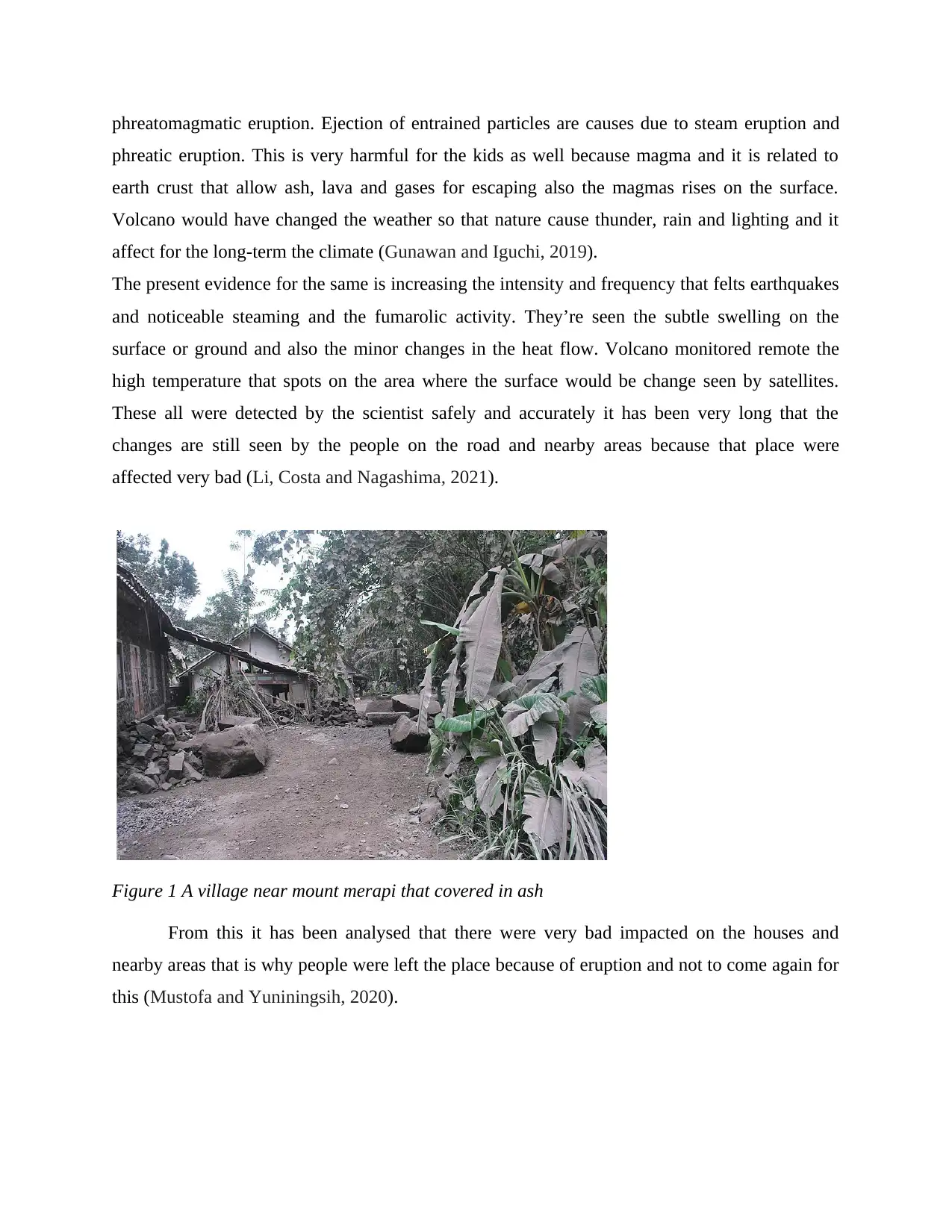
phreatomagmatic eruption. Ejection of entrained particles are causes due to steam eruption and
phreatic eruption. This is very harmful for the kids as well because magma and it is related to
earth crust that allow ash, lava and gases for escaping also the magmas rises on the surface.
Volcano would have changed the weather so that nature cause thunder, rain and lighting and it
affect for the long-term the climate (Gunawan and Iguchi, 2019).
The present evidence for the same is increasing the intensity and frequency that felts earthquakes
and noticeable steaming and the fumarolic activity. They’re seen the subtle swelling on the
surface or ground and also the minor changes in the heat flow. Volcano monitored remote the
high temperature that spots on the area where the surface would be change seen by satellites.
These all were detected by the scientist safely and accurately it has been very long that the
changes are still seen by the people on the road and nearby areas because that place were
affected very bad (Li, Costa and Nagashima, 2021).
Figure 1 A village near mount merapi that covered in ash
From this it has been analysed that there were very bad impacted on the houses and
nearby areas that is why people were left the place because of eruption and not to come again for
this (Mustofa and Yuniningsih, 2020).
phreatic eruption. This is very harmful for the kids as well because magma and it is related to
earth crust that allow ash, lava and gases for escaping also the magmas rises on the surface.
Volcano would have changed the weather so that nature cause thunder, rain and lighting and it
affect for the long-term the climate (Gunawan and Iguchi, 2019).
The present evidence for the same is increasing the intensity and frequency that felts earthquakes
and noticeable steaming and the fumarolic activity. They’re seen the subtle swelling on the
surface or ground and also the minor changes in the heat flow. Volcano monitored remote the
high temperature that spots on the area where the surface would be change seen by satellites.
These all were detected by the scientist safely and accurately it has been very long that the
changes are still seen by the people on the road and nearby areas because that place were
affected very bad (Li, Costa and Nagashima, 2021).
Figure 1 A village near mount merapi that covered in ash
From this it has been analysed that there were very bad impacted on the houses and
nearby areas that is why people were left the place because of eruption and not to come again for
this (Mustofa and Yuniningsih, 2020).

Figure 2 People are affected from eruption
There are so many people who are badly affected due to this, also newspaper and BBC
news were share the information and government start doing their help by providing them helper
and rescue them (Hadmoko and Gomez, 2018). Also provided shelter for those who don’t have
place for lining, that is the present evidence related to this are seen in the people who are
suffering from the disease and their skin were burn that were affected badly on the people.
Future disaster context
Natural disasters such as Mount Merapi volcanic eruption have adverse effects on the
tourism related activities but it is not all bad. Such incidents can helps in boosting the tourism of
the place as there are many travelers interested in visiting such places. The coverage from the
media channels of the disaster helps in gaining popularity for the place with high publicity that
will help in increasing the number of tourists. Such incidents are far and few that makes the
travelers interested in watching the affected area. Moreover, these disasters will encourage
enthusiasts such as storm chasers as well as individuals with a hobby of photography that wants
to capture the destructive beauty of calamities (Haryadi, Sunarto, and Sugiyarto, 2019). There
are many negative consequences of natural disasters such as volcano eruption on the tourism and
related activities where it is the main source that supports the economy. It is important to plan for
a disaster from prior basis rather than being in a fury when nature strikes.
In the recovery phase, it includes inviting more tourists to return and get the economy of
the place on track. Events such as volcano eruption is very life threatening as a part of natural
disaster, eruption is imminent and it is important to have immediate security and safety from the
same. There are many things that can be done to avoid any consequences from eruption. Long
before the , there are several signs leading to notice the future eruption (Paripurno, Wicaksana
There are so many people who are badly affected due to this, also newspaper and BBC
news were share the information and government start doing their help by providing them helper
and rescue them (Hadmoko and Gomez, 2018). Also provided shelter for those who don’t have
place for lining, that is the present evidence related to this are seen in the people who are
suffering from the disease and their skin were burn that were affected badly on the people.
Future disaster context
Natural disasters such as Mount Merapi volcanic eruption have adverse effects on the
tourism related activities but it is not all bad. Such incidents can helps in boosting the tourism of
the place as there are many travelers interested in visiting such places. The coverage from the
media channels of the disaster helps in gaining popularity for the place with high publicity that
will help in increasing the number of tourists. Such incidents are far and few that makes the
travelers interested in watching the affected area. Moreover, these disasters will encourage
enthusiasts such as storm chasers as well as individuals with a hobby of photography that wants
to capture the destructive beauty of calamities (Haryadi, Sunarto, and Sugiyarto, 2019). There
are many negative consequences of natural disasters such as volcano eruption on the tourism and
related activities where it is the main source that supports the economy. It is important to plan for
a disaster from prior basis rather than being in a fury when nature strikes.
In the recovery phase, it includes inviting more tourists to return and get the economy of
the place on track. Events such as volcano eruption is very life threatening as a part of natural
disaster, eruption is imminent and it is important to have immediate security and safety from the
same. There are many things that can be done to avoid any consequences from eruption. Long
before the , there are several signs leading to notice the future eruption (Paripurno, Wicaksana
Paraphrase This Document
Need a fresh take? Get an instant paraphrase of this document with our AI Paraphraser
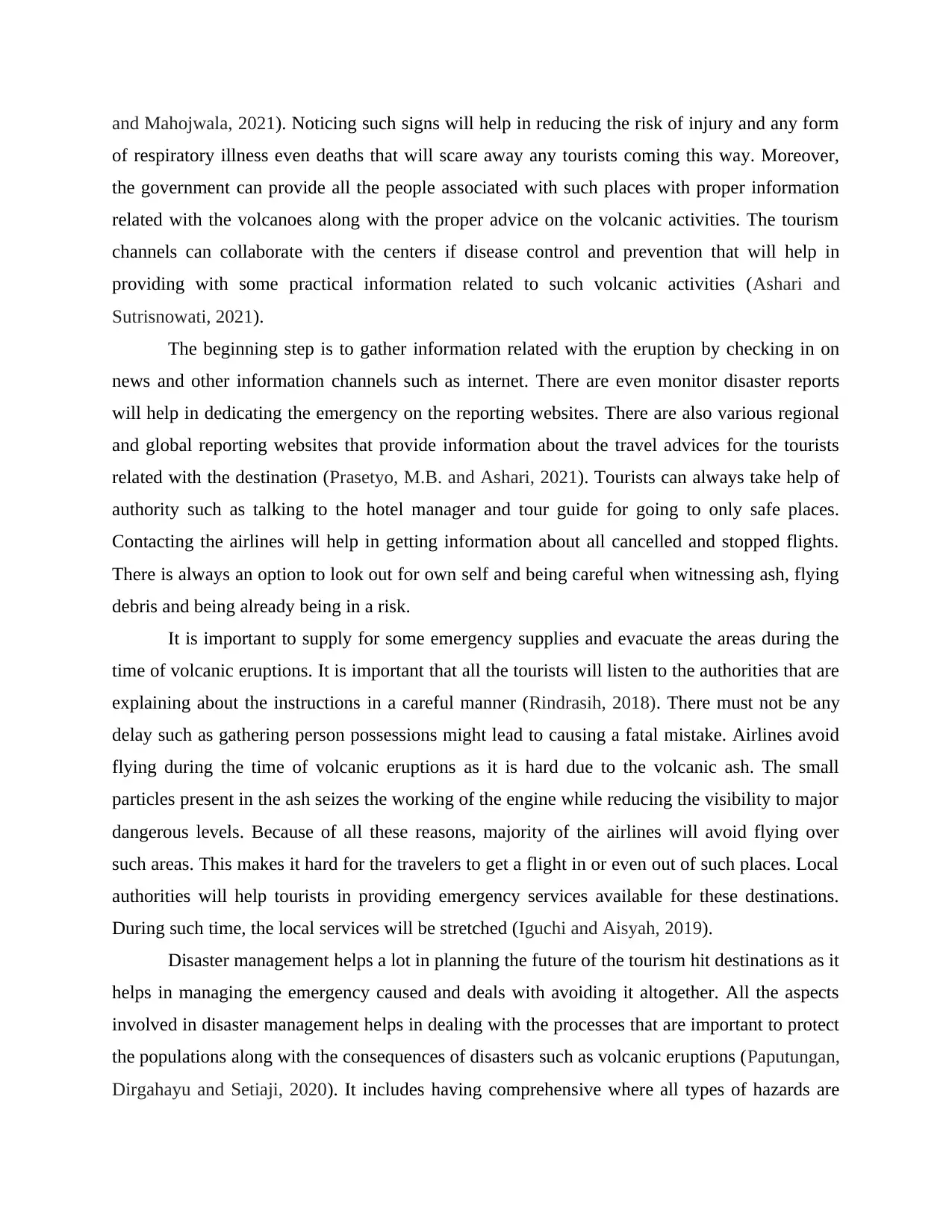
and Mahojwala, 2021). Noticing such signs will help in reducing the risk of injury and any form
of respiratory illness even deaths that will scare away any tourists coming this way. Moreover,
the government can provide all the people associated with such places with proper information
related with the volcanoes along with the proper advice on the volcanic activities. The tourism
channels can collaborate with the centers if disease control and prevention that will help in
providing with some practical information related to such volcanic activities (Ashari and
Sutrisnowati, 2021).
The beginning step is to gather information related with the eruption by checking in on
news and other information channels such as internet. There are even monitor disaster reports
will help in dedicating the emergency on the reporting websites. There are also various regional
and global reporting websites that provide information about the travel advices for the tourists
related with the destination (Prasetyo, M.B. and Ashari, 2021). Tourists can always take help of
authority such as talking to the hotel manager and tour guide for going to only safe places.
Contacting the airlines will help in getting information about all cancelled and stopped flights.
There is always an option to look out for own self and being careful when witnessing ash, flying
debris and being already being in a risk.
It is important to supply for some emergency supplies and evacuate the areas during the
time of volcanic eruptions. It is important that all the tourists will listen to the authorities that are
explaining about the instructions in a careful manner (Rindrasih, 2018). There must not be any
delay such as gathering person possessions might lead to causing a fatal mistake. Airlines avoid
flying during the time of volcanic eruptions as it is hard due to the volcanic ash. The small
particles present in the ash seizes the working of the engine while reducing the visibility to major
dangerous levels. Because of all these reasons, majority of the airlines will avoid flying over
such areas. This makes it hard for the travelers to get a flight in or even out of such places. Local
authorities will help tourists in providing emergency services available for these destinations.
During such time, the local services will be stretched (Iguchi and Aisyah, 2019).
Disaster management helps a lot in planning the future of the tourism hit destinations as it
helps in managing the emergency caused and deals with avoiding it altogether. All the aspects
involved in disaster management helps in dealing with the processes that are important to protect
the populations along with the consequences of disasters such as volcanic eruptions (Paputungan,
Dirgahayu and Setiaji, 2020). It includes having comprehensive where all types of hazards are
of respiratory illness even deaths that will scare away any tourists coming this way. Moreover,
the government can provide all the people associated with such places with proper information
related with the volcanoes along with the proper advice on the volcanic activities. The tourism
channels can collaborate with the centers if disease control and prevention that will help in
providing with some practical information related to such volcanic activities (Ashari and
Sutrisnowati, 2021).
The beginning step is to gather information related with the eruption by checking in on
news and other information channels such as internet. There are even monitor disaster reports
will help in dedicating the emergency on the reporting websites. There are also various regional
and global reporting websites that provide information about the travel advices for the tourists
related with the destination (Prasetyo, M.B. and Ashari, 2021). Tourists can always take help of
authority such as talking to the hotel manager and tour guide for going to only safe places.
Contacting the airlines will help in getting information about all cancelled and stopped flights.
There is always an option to look out for own self and being careful when witnessing ash, flying
debris and being already being in a risk.
It is important to supply for some emergency supplies and evacuate the areas during the
time of volcanic eruptions. It is important that all the tourists will listen to the authorities that are
explaining about the instructions in a careful manner (Rindrasih, 2018). There must not be any
delay such as gathering person possessions might lead to causing a fatal mistake. Airlines avoid
flying during the time of volcanic eruptions as it is hard due to the volcanic ash. The small
particles present in the ash seizes the working of the engine while reducing the visibility to major
dangerous levels. Because of all these reasons, majority of the airlines will avoid flying over
such areas. This makes it hard for the travelers to get a flight in or even out of such places. Local
authorities will help tourists in providing emergency services available for these destinations.
During such time, the local services will be stretched (Iguchi and Aisyah, 2019).
Disaster management helps a lot in planning the future of the tourism hit destinations as it
helps in managing the emergency caused and deals with avoiding it altogether. All the aspects
involved in disaster management helps in dealing with the processes that are important to protect
the populations along with the consequences of disasters such as volcanic eruptions (Paputungan,
Dirgahayu and Setiaji, 2020). It includes having comprehensive where all types of hazards are

taken into account, progressive where the preventive and preparatory measures are taken into
consideration. This management approach is risk- driven and conducting risk analysis while
assigning priorities as well as resources.
consideration. This management approach is risk- driven and conducting risk analysis while
assigning priorities as well as resources.
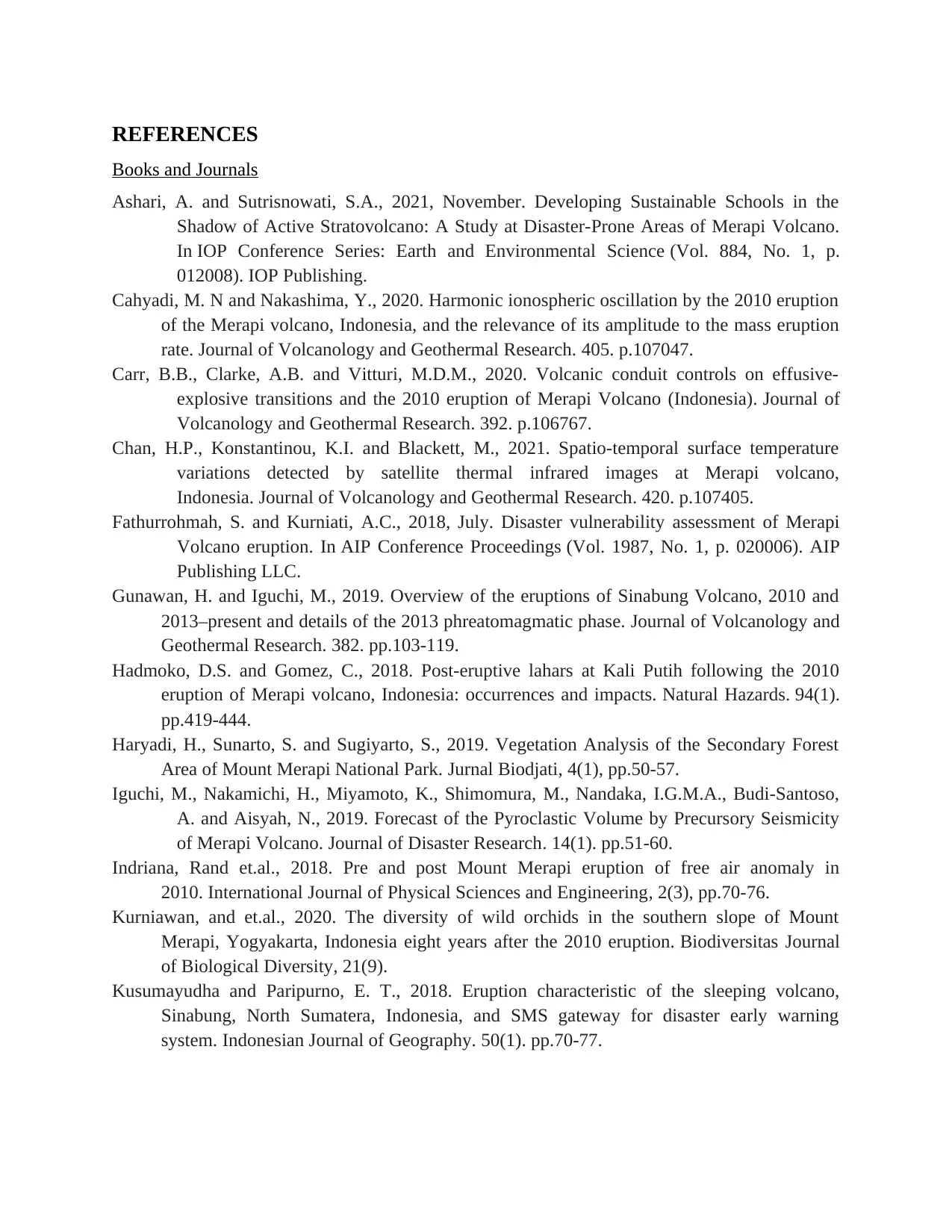
REFERENCES
Books and Journals
Ashari, A. and Sutrisnowati, S.A., 2021, November. Developing Sustainable Schools in the
Shadow of Active Stratovolcano: A Study at Disaster-Prone Areas of Merapi Volcano.
In IOP Conference Series: Earth and Environmental Science (Vol. 884, No. 1, p.
012008). IOP Publishing.
Cahyadi, M. N and Nakashima, Y., 2020. Harmonic ionospheric oscillation by the 2010 eruption
of the Merapi volcano, Indonesia, and the relevance of its amplitude to the mass eruption
rate. Journal of Volcanology and Geothermal Research. 405. p.107047.
Carr, B.B., Clarke, A.B. and Vitturi, M.D.M., 2020. Volcanic conduit controls on effusive-
explosive transitions and the 2010 eruption of Merapi Volcano (Indonesia). Journal of
Volcanology and Geothermal Research. 392. p.106767.
Chan, H.P., Konstantinou, K.I. and Blackett, M., 2021. Spatio-temporal surface temperature
variations detected by satellite thermal infrared images at Merapi volcano,
Indonesia. Journal of Volcanology and Geothermal Research. 420. p.107405.
Fathurrohmah, S. and Kurniati, A.C., 2018, July. Disaster vulnerability assessment of Merapi
Volcano eruption. In AIP Conference Proceedings (Vol. 1987, No. 1, p. 020006). AIP
Publishing LLC.
Gunawan, H. and Iguchi, M., 2019. Overview of the eruptions of Sinabung Volcano, 2010 and
2013–present and details of the 2013 phreatomagmatic phase. Journal of Volcanology and
Geothermal Research. 382. pp.103-119.
Hadmoko, D.S. and Gomez, C., 2018. Post-eruptive lahars at Kali Putih following the 2010
eruption of Merapi volcano, Indonesia: occurrences and impacts. Natural Hazards. 94(1).
pp.419-444.
Haryadi, H., Sunarto, S. and Sugiyarto, S., 2019. Vegetation Analysis of the Secondary Forest
Area of Mount Merapi National Park. Jurnal Biodjati, 4(1), pp.50-57.
Iguchi, M., Nakamichi, H., Miyamoto, K., Shimomura, M., Nandaka, I.G.M.A., Budi-Santoso,
A. and Aisyah, N., 2019. Forecast of the Pyroclastic Volume by Precursory Seismicity
of Merapi Volcano. Journal of Disaster Research. 14(1). pp.51-60.
Indriana, Rand et.al., 2018. Pre and post Mount Merapi eruption of free air anomaly in
2010. International Journal of Physical Sciences and Engineering, 2(3), pp.70-76.
Kurniawan, and et.al., 2020. The diversity of wild orchids in the southern slope of Mount
Merapi, Yogyakarta, Indonesia eight years after the 2010 eruption. Biodiversitas Journal
of Biological Diversity, 21(9).
Kusumayudha and Paripurno, E. T., 2018. Eruption characteristic of the sleeping volcano,
Sinabung, North Sumatera, Indonesia, and SMS gateway for disaster early warning
system. Indonesian Journal of Geography. 50(1). pp.70-77.
Books and Journals
Ashari, A. and Sutrisnowati, S.A., 2021, November. Developing Sustainable Schools in the
Shadow of Active Stratovolcano: A Study at Disaster-Prone Areas of Merapi Volcano.
In IOP Conference Series: Earth and Environmental Science (Vol. 884, No. 1, p.
012008). IOP Publishing.
Cahyadi, M. N and Nakashima, Y., 2020. Harmonic ionospheric oscillation by the 2010 eruption
of the Merapi volcano, Indonesia, and the relevance of its amplitude to the mass eruption
rate. Journal of Volcanology and Geothermal Research. 405. p.107047.
Carr, B.B., Clarke, A.B. and Vitturi, M.D.M., 2020. Volcanic conduit controls on effusive-
explosive transitions and the 2010 eruption of Merapi Volcano (Indonesia). Journal of
Volcanology and Geothermal Research. 392. p.106767.
Chan, H.P., Konstantinou, K.I. and Blackett, M., 2021. Spatio-temporal surface temperature
variations detected by satellite thermal infrared images at Merapi volcano,
Indonesia. Journal of Volcanology and Geothermal Research. 420. p.107405.
Fathurrohmah, S. and Kurniati, A.C., 2018, July. Disaster vulnerability assessment of Merapi
Volcano eruption. In AIP Conference Proceedings (Vol. 1987, No. 1, p. 020006). AIP
Publishing LLC.
Gunawan, H. and Iguchi, M., 2019. Overview of the eruptions of Sinabung Volcano, 2010 and
2013–present and details of the 2013 phreatomagmatic phase. Journal of Volcanology and
Geothermal Research. 382. pp.103-119.
Hadmoko, D.S. and Gomez, C., 2018. Post-eruptive lahars at Kali Putih following the 2010
eruption of Merapi volcano, Indonesia: occurrences and impacts. Natural Hazards. 94(1).
pp.419-444.
Haryadi, H., Sunarto, S. and Sugiyarto, S., 2019. Vegetation Analysis of the Secondary Forest
Area of Mount Merapi National Park. Jurnal Biodjati, 4(1), pp.50-57.
Iguchi, M., Nakamichi, H., Miyamoto, K., Shimomura, M., Nandaka, I.G.M.A., Budi-Santoso,
A. and Aisyah, N., 2019. Forecast of the Pyroclastic Volume by Precursory Seismicity
of Merapi Volcano. Journal of Disaster Research. 14(1). pp.51-60.
Indriana, Rand et.al., 2018. Pre and post Mount Merapi eruption of free air anomaly in
2010. International Journal of Physical Sciences and Engineering, 2(3), pp.70-76.
Kurniawan, and et.al., 2020. The diversity of wild orchids in the southern slope of Mount
Merapi, Yogyakarta, Indonesia eight years after the 2010 eruption. Biodiversitas Journal
of Biological Diversity, 21(9).
Kusumayudha and Paripurno, E. T., 2018. Eruption characteristic of the sleeping volcano,
Sinabung, North Sumatera, Indonesia, and SMS gateway for disaster early warning
system. Indonesian Journal of Geography. 50(1). pp.70-77.
Secure Best Marks with AI Grader
Need help grading? Try our AI Grader for instant feedback on your assignments.
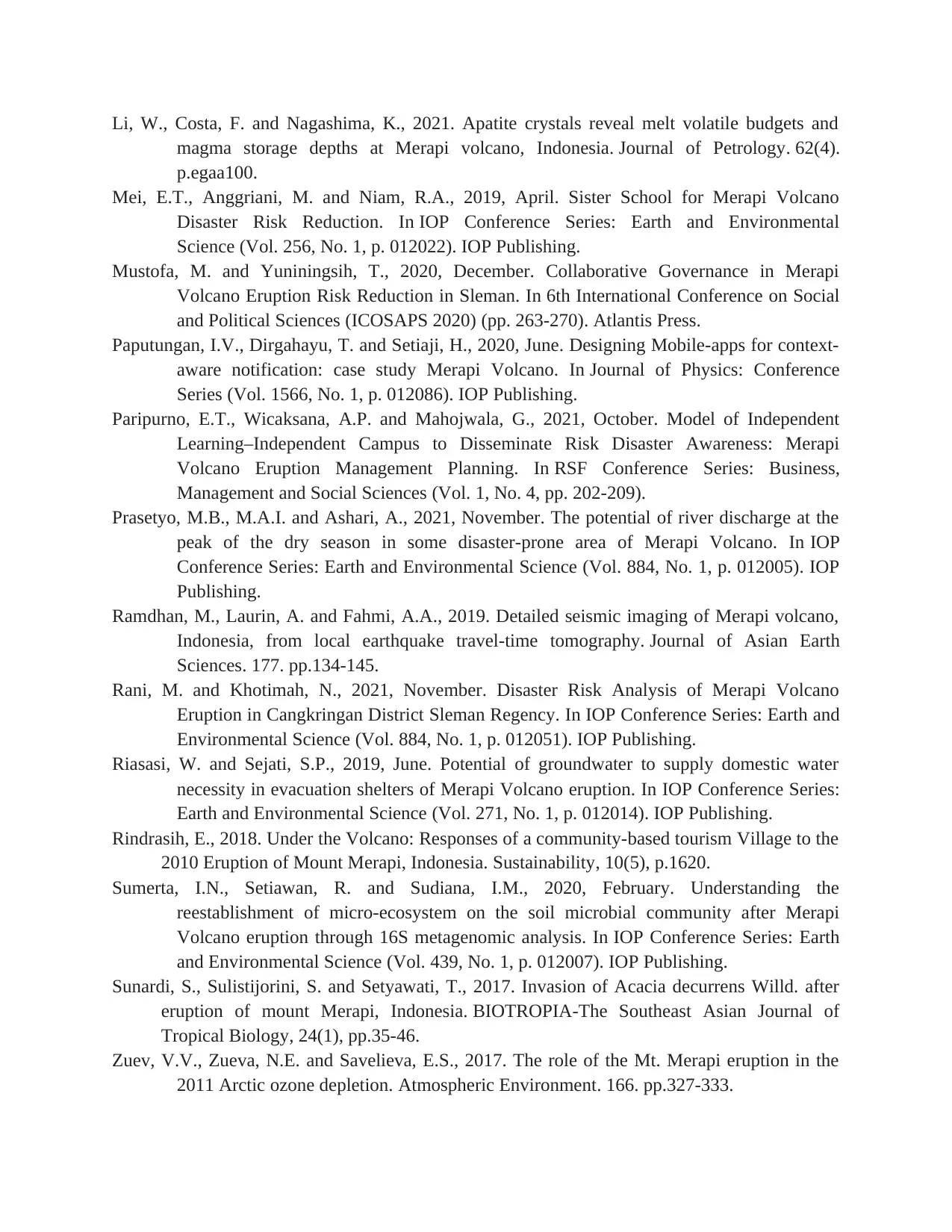
Li, W., Costa, F. and Nagashima, K., 2021. Apatite crystals reveal melt volatile budgets and
magma storage depths at Merapi volcano, Indonesia. Journal of Petrology. 62(4).
p.egaa100.
Mei, E.T., Anggriani, M. and Niam, R.A., 2019, April. Sister School for Merapi Volcano
Disaster Risk Reduction. In IOP Conference Series: Earth and Environmental
Science (Vol. 256, No. 1, p. 012022). IOP Publishing.
Mustofa, M. and Yuniningsih, T., 2020, December. Collaborative Governance in Merapi
Volcano Eruption Risk Reduction in Sleman. In 6th International Conference on Social
and Political Sciences (ICOSAPS 2020) (pp. 263-270). Atlantis Press.
Paputungan, I.V., Dirgahayu, T. and Setiaji, H., 2020, June. Designing Mobile-apps for context-
aware notification: case study Merapi Volcano. In Journal of Physics: Conference
Series (Vol. 1566, No. 1, p. 012086). IOP Publishing.
Paripurno, E.T., Wicaksana, A.P. and Mahojwala, G., 2021, October. Model of Independent
Learning–Independent Campus to Disseminate Risk Disaster Awareness: Merapi
Volcano Eruption Management Planning. In RSF Conference Series: Business,
Management and Social Sciences (Vol. 1, No. 4, pp. 202-209).
Prasetyo, M.B., M.A.I. and Ashari, A., 2021, November. The potential of river discharge at the
peak of the dry season in some disaster-prone area of Merapi Volcano. In IOP
Conference Series: Earth and Environmental Science (Vol. 884, No. 1, p. 012005). IOP
Publishing.
Ramdhan, M., Laurin, A. and Fahmi, A.A., 2019. Detailed seismic imaging of Merapi volcano,
Indonesia, from local earthquake travel-time tomography. Journal of Asian Earth
Sciences. 177. pp.134-145.
Rani, M. and Khotimah, N., 2021, November. Disaster Risk Analysis of Merapi Volcano
Eruption in Cangkringan District Sleman Regency. In IOP Conference Series: Earth and
Environmental Science (Vol. 884, No. 1, p. 012051). IOP Publishing.
Riasasi, W. and Sejati, S.P., 2019, June. Potential of groundwater to supply domestic water
necessity in evacuation shelters of Merapi Volcano eruption. In IOP Conference Series:
Earth and Environmental Science (Vol. 271, No. 1, p. 012014). IOP Publishing.
Rindrasih, E., 2018. Under the Volcano: Responses of a community-based tourism Village to the
2010 Eruption of Mount Merapi, Indonesia. Sustainability, 10(5), p.1620.
Sumerta, I.N., Setiawan, R. and Sudiana, I.M., 2020, February. Understanding the
reestablishment of micro-ecosystem on the soil microbial community after Merapi
Volcano eruption through 16S metagenomic analysis. In IOP Conference Series: Earth
and Environmental Science (Vol. 439, No. 1, p. 012007). IOP Publishing.
Sunardi, S., Sulistijorini, S. and Setyawati, T., 2017. Invasion of Acacia decurrens Willd. after
eruption of mount Merapi, Indonesia. BIOTROPIA-The Southeast Asian Journal of
Tropical Biology, 24(1), pp.35-46.
Zuev, V.V., Zueva, N.E. and Savelieva, E.S., 2017. The role of the Mt. Merapi eruption in the
2011 Arctic ozone depletion. Atmospheric Environment. 166. pp.327-333.
magma storage depths at Merapi volcano, Indonesia. Journal of Petrology. 62(4).
p.egaa100.
Mei, E.T., Anggriani, M. and Niam, R.A., 2019, April. Sister School for Merapi Volcano
Disaster Risk Reduction. In IOP Conference Series: Earth and Environmental
Science (Vol. 256, No. 1, p. 012022). IOP Publishing.
Mustofa, M. and Yuniningsih, T., 2020, December. Collaborative Governance in Merapi
Volcano Eruption Risk Reduction in Sleman. In 6th International Conference on Social
and Political Sciences (ICOSAPS 2020) (pp. 263-270). Atlantis Press.
Paputungan, I.V., Dirgahayu, T. and Setiaji, H., 2020, June. Designing Mobile-apps for context-
aware notification: case study Merapi Volcano. In Journal of Physics: Conference
Series (Vol. 1566, No. 1, p. 012086). IOP Publishing.
Paripurno, E.T., Wicaksana, A.P. and Mahojwala, G., 2021, October. Model of Independent
Learning–Independent Campus to Disseminate Risk Disaster Awareness: Merapi
Volcano Eruption Management Planning. In RSF Conference Series: Business,
Management and Social Sciences (Vol. 1, No. 4, pp. 202-209).
Prasetyo, M.B., M.A.I. and Ashari, A., 2021, November. The potential of river discharge at the
peak of the dry season in some disaster-prone area of Merapi Volcano. In IOP
Conference Series: Earth and Environmental Science (Vol. 884, No. 1, p. 012005). IOP
Publishing.
Ramdhan, M., Laurin, A. and Fahmi, A.A., 2019. Detailed seismic imaging of Merapi volcano,
Indonesia, from local earthquake travel-time tomography. Journal of Asian Earth
Sciences. 177. pp.134-145.
Rani, M. and Khotimah, N., 2021, November. Disaster Risk Analysis of Merapi Volcano
Eruption in Cangkringan District Sleman Regency. In IOP Conference Series: Earth and
Environmental Science (Vol. 884, No. 1, p. 012051). IOP Publishing.
Riasasi, W. and Sejati, S.P., 2019, June. Potential of groundwater to supply domestic water
necessity in evacuation shelters of Merapi Volcano eruption. In IOP Conference Series:
Earth and Environmental Science (Vol. 271, No. 1, p. 012014). IOP Publishing.
Rindrasih, E., 2018. Under the Volcano: Responses of a community-based tourism Village to the
2010 Eruption of Mount Merapi, Indonesia. Sustainability, 10(5), p.1620.
Sumerta, I.N., Setiawan, R. and Sudiana, I.M., 2020, February. Understanding the
reestablishment of micro-ecosystem on the soil microbial community after Merapi
Volcano eruption through 16S metagenomic analysis. In IOP Conference Series: Earth
and Environmental Science (Vol. 439, No. 1, p. 012007). IOP Publishing.
Sunardi, S., Sulistijorini, S. and Setyawati, T., 2017. Invasion of Acacia decurrens Willd. after
eruption of mount Merapi, Indonesia. BIOTROPIA-The Southeast Asian Journal of
Tropical Biology, 24(1), pp.35-46.
Zuev, V.V., Zueva, N.E. and Savelieva, E.S., 2017. The role of the Mt. Merapi eruption in the
2011 Arctic ozone depletion. Atmospheric Environment. 166. pp.327-333.
1 out of 11
Related Documents
Your All-in-One AI-Powered Toolkit for Academic Success.
+13062052269
info@desklib.com
Available 24*7 on WhatsApp / Email
![[object Object]](/_next/static/media/star-bottom.7253800d.svg)
Unlock your academic potential
© 2024 | Zucol Services PVT LTD | All rights reserved.

